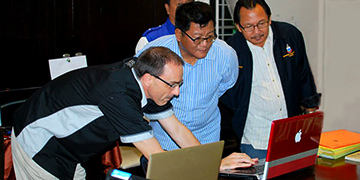Q: Where can I host my online dictionary?
A: The webserver webonary.work is set up for the use of webonary. All one needs to do is import one’s data and adjust the template. We’ll be happy to show you how this can be done.
Q: Why did you decide to use WordPress instead of Drupal?
A: After the success of the initial proof of concept using WordPress, we did consider Drupal. By all accounts we found, Drupal is more difficult to learn and manage than WordPress. Our goal all along has been to make the task of publishing dictionaries online as easy as possible, with a minimum of technical help. WordPress also dominates the CMS world. It has 55% market share, 9 times more than Drupal, ensuring a broad support base. So we chose to continue working with WordPress. Those of us who have worked with WordPress have enjoyed it.
Q: Why can't Webonary just use a LIFT file?
A: So far, no linguist we've met wants to publish all their data online for the world to see. For instance, a number of entries may still need work, and linguists don't want those appearing on a website yet, any more than they want them appearing in a published book. They want to pick and choose what entries to show.
Linguists also want the entries to look right. They need some way to do that as well.
FieldWorks solves both problems and supports LIFT. FieldWorks allows linguists to select entries and configure the data to look the way they want it. Once they do that, they can export their Configured Dictionary, which can then be imported into Webonary.
Q: The search results look like they're in the wrong order. Are you sure search is working right?
A: When we first worked on the search engine, we returned all the search results in alphabetic order by headword. That didn't work very well. For example, a search on "spring" could return a word for a vegetable grown in the spring, and that word might rise fairly high in the search results. But that is certainly not the word the person was looking for. He wanted a word for the season of spring.
So we weighted search results such that entries in which a person is more likely to be interested in seeing will rise to the top of the search results. For example, if "spring" is found in a headword, that entry will rise to the top. But if "spring" is found in the definition of an entry, it will sink lower in search results.
Currently, the weighting is as follows:
- headword
- complex forms of headwords e.g., compound words, derived forms, phrases, etc.
- underlying linguistic forms of headwords
- variant forms of headwords
- definitions of headwords
- semantic domains, i.e., areas of meanings of headwords
- custom fields e.g., singular or plural forms of headwords
- example sentences
Reversal entries are treated the same as headwords. Therefore, "spring" may not appear anywhere in the entry, but the entry might still appear quite high in the search results.
If several entries have the same weight, a secondary sorting takes place. Those words that have shorter definitions will appear ahead of words with longer ones. So the entry with the definition "The first season" will appear before "A vegetable grown during spring, primarily as a cash crop." The concept is that a shorter definition has a better chance of being the word that a person is looking for than a longer one.
Finally, if two entries are weighted the same, and have the exact same length, the entries are sorted alphabetically by headword.
Q: Is it possible to use one's own theme?
A: Webonary was built such that any theme could work with it, but the theme probably won’t look right. For instance, if you use the default theme Twenty Eleven, it will work, but it will show the date of the post entry. You most likely don’t want that in your dictionary entries. Nor will Twenty Eleven show the Languages or Parts of Speech drop down boxes below the search bar.
Recognizing this, we provided a theme that you can use out of the box. However, we also recognize that most people will want to use a different theme than the one we provided. Different themes are constructed in different ways, and we cannot possibly hope to advise how to customize each of them. But we can show you our theme. A programmer can use that as an example or a template to customize a different theme.
Keep in mind that we are using the WordPress posts for dictionary entries. In other words, each dictionary entry is a post in WordPress. That allowed us to leverage WordPress search, categories, and such. We were able to produce a dictionary platform in a fraction of the time that we would have otherwise spent in building an infrastructure. But what that also means is that you can no longer use that WordPress installation for a blog. You’ll need a separate WordPress installation for that–or a second WordPress installation for Webonary if you already have a blog set up.

 Webonary gives language groups the ability to publish bilingual or multilingual dictionaries on the web with a minimum of technical help.
Webonary gives language groups the ability to publish bilingual or multilingual dictionaries on the web with a minimum of technical help. With lexical data in FLEx, the process is simple: 1.
With lexical data in FLEx, the process is simple: 1. 
